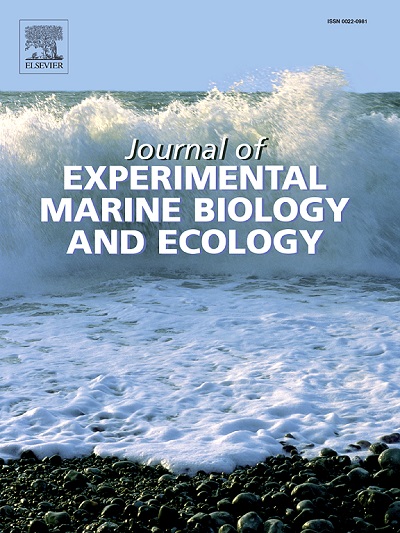圈养降低了唐氏桡足类动物对捕食者线索的敏感性
IF 1.8
3区 生物学
Q3 ECOLOGY
Journal of Experimental Marine Biology and Ecology
Pub Date : 2025-02-18
DOI:10.1016/j.jembe.2025.152091
引用次数: 0
摘要
圈养种群往往受到与野生种群不同的选择压力,这可能导致这些种群之间的性状差异。摘要本研究探讨了圈养对海洋桡足类浮游动物Acartia tonsa的游泳行为和逃跑反应的影响。Acartia tonsa是一种利用流体机械信号探测来帮助寻找食物、定位配偶和躲避捕食者的海洋桡足类浮游动物。与野生种群相比,圈养的tonsa种群经历了更少的种间捕食和更高的种群密度,假设这些差异可能推动了该物种游泳行为的适应性进化。通过对人工饲养和野生饲养的黄鳝的游泳速度、跳跃次数、跳跃距离、跳跃频率进行比较,发现野生饲养的黄鳝比人工饲养的黄鳝游得更快、跳得更频繁。然而,当使用人工捕食者模拟比较人工饲养和野生捕获的种群的逃跑反应时,在逃跑反应中进行的连续跳跃次数,最大反应速度或反应过程中行进的总距离方面没有发现显着差异。尽管人工饲养的桡足类和野生捕获的桡足类的逃跑反应相似,但人工饲养的桡足类对模拟捕食者通常没有反应(34%的个体对模拟捕食者有反应),而野生个体几乎总是有反应(96%的个体有反应)。这表明,与野生桡足动物相比,圈养饲养可能导致圈养桡足动物对流体机械信号的敏感性降低,因为在没有捕食者的圈养环境中对这些信号做出反应会增加不必要的能量成本。该研究为人工饲养如何影响桡足类种群提供了新的见解,并为捕食者驱动的进化和密度依赖选择如何影响桡足类物种的行为提供了证据。本文章由计算机程序翻译,如有差异,请以英文原文为准。
Captive rearing reduces the sensitivity of Acartia tonsa copepods to predator cues
Captive populations are often subject to different selective pressures than their wild counterparts, which could result in trait differences between these populations. This study investigates the effect of captive rearing on the swimming behavior and escape responses of Acartia tonsa, a species of marine copepod zooplankton that use hydromechanical signal detection to aid in finding food, locating mates, and avoiding predation. As captive populations of A. tonsa experience reduced interspecific predation and higher population densities compared to wild populations, it was hypothesized that these differences may drive adaptive evolution of swimming behavior in this species. Several components of routine swimming were compared (swimming speed, number of hops, distance of hops, frequency of hops) for groups of captive-reared and wild-caught A. tonsa, revealing that wild-caught copepods swim faster and hop more frequently than captive-reared copepods. However, when the escape responses of the captive-reared and wild-caught populations were compared using an artificial predator mimic, no significant differences were found in the number of sequential hops performed during the escape response, the maximum velocity of the response, or the total distance traveled during the response. Although the escape responses performed by the captive-reared and wild-caught copepods were similar, the captive-reared individuals often showed no response to the artificial predator mimic (34 % of individuals responded to the predator mimic), whereas wild individuals almost always showed a response (96 % responded). This suggests that captive rearing may have resulted in reduced sensitivity to hydromechanical signals in captive copepods compared to wild copepods, as responding to these signals in a predator-free captive environment would impose an unnecessary energy cost. This study offers new insight into how captive-rearing may impact copepod populations and provides evidence of how predator-driven evolution and density dependent selection may influence the behavior of copepod species.
求助全文
通过发布文献求助,成功后即可免费获取论文全文。
去求助
来源期刊
CiteScore
4.30
自引率
0.00%
发文量
98
审稿时长
14 weeks
期刊介绍:
The Journal of Experimental Marine Biology and Ecology provides a forum for experimental ecological research on marine organisms in relation to their environment. Topic areas include studies that focus on biochemistry, physiology, behavior, genetics, and ecological theory. The main emphasis of the Journal lies in hypothesis driven experimental work, both from the laboratory and the field. Natural experiments or descriptive studies that elucidate fundamental ecological processes are welcome. Submissions should have a broad ecological framework beyond the specific study organism or geographic region.
Short communications that highlight emerging issues and exciting discoveries within five printed pages will receive a rapid turnaround. Papers describing important new analytical, computational, experimental and theoretical techniques and methods are encouraged and will be highlighted as Methodological Advances. We welcome proposals for Review Papers synthesizing a specific field within marine ecology. Finally, the journal aims to publish Special Issues at regular intervals synthesizing a particular field of marine science. All printed papers undergo a peer review process before being accepted and will receive a first decision within three months.

 求助内容:
求助内容: 应助结果提醒方式:
应助结果提醒方式:


